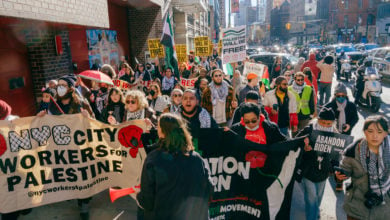The
following is adapted from a talk presented at a meeting of the Party for
Socialism and Liberation in San Francisco, April 2.
March 30, Land
Day, commemorated the Palestinian people’s struggle for self-determination. This day is marked by Palestinians all over the world. On March 29, 1976,
more than 1,000 Palestinians living within the 1948 borders of Israel marched
through Jaffa, chanting and carrying Palestinian flags to denounce Israel’s
plans to demolish over 500 homes. The next day, a general strike was held. Israel
killed six Palestinians participating in the
demonstrations.
 Villagers in Rumaneh, west of Jenin, march on Land Day. |
Today, 34 years later, Israel continues to
terrorize and evict Palestinian families and demolish homes across the West
Bank and in Jerusalem. It is fitting on this occasion to go over the situation
in Palestine and also to analyze the rift that has developed between Washington
and Tel Aviv.
Gaza
under siege
Dec. 27, 2009, marked one
year since the beginning of Israel’s 2008-2009 brutal siege and invasion of
Gaza. The three-week land and air assault on Gaza was a highly concentrated use
of firepower directed overwhelmingly at civilians. As a result of Israel’s
barbarity, opposition to the occupation around the world has escalated.
The beginning of the attack
involved 54 warplanes bombing civilian and government buildings. During the
first nine hours of the attack, 100 tons of munitions were dropped on the Gaza
Strip. In all, 1,440 Palestinians were killed, including 926 civilians. Over
5,000 people were wounded and thousands of homes destroyed. Israeli forces
targeted women and children, ambulance drivers, and schools and hospitals and
destroyed as much infrastructure as they could. They used highly destructive
weapons, including banned phosphorus munitions.
The Gaza Strip has the sixth
highest population density in the world, with 1.5 million people forced into an
area of 139 square miles. Four thousand homes were destroyed, leaving 50,800
Gazans displaced. The total damage has been estimated at over $2 billion.
Following the military
attacks, Israel has strengthened its debilitating blockade on Gaza. Access to
electricity, natural gas and other sources of fuel is severely limited.
Palestinians living in Gaza are generally unable to rebuild their homes,
businesses and schools, since Israel refuses to let steel and cement through
the border crossings.
The situation of political prisoners
For decades, Palestinians,
confronted with great violence, have tirelessly struggled against the crimes of
the state of Israel. It is instructive to look at the situation of political
prisoners in this so-called democracy.
A Palestinian researcher,
Abdul-Nasser Farawna, a former political prisoner himself, has come up with
statistics on Palestinian prisoners held by Israel. There are currently 8,200
Palestinians imprisoned, among them 320 children. The number of detainees who
have died in detention is 197, and hundreds of detainees have died after their
release due to health complications resulting from torture and medical
negligence during interrogation. Hundreds of detainees have been in solitary
confinement for several months, in some cases for several years, and are
deprived of visitation rights.
A
former Israeli military commander, Eran Erafti, detailed the widespread abuse
and torture of Palestinian youth by occupying Israeli soldiers: “You take the
kid, you blindfold him, you handcuff him, he’s really shaking. … Sometimes you
cuff his legs too. Sometimes it cuts off the circulation.” Erafti acknowledged
that some of the kids are as young as nine or 10.
Of the 9,000 Palestinians
arrested in 2009 by Israel, 700 were children. These children are tried in
military tribunals in which anyone over the age of 16 is tried as an adult.
The West Bank and the two-state ‘solution’
Since the formation of the
state of Israel, its military strategy has not only been to conquer land, but
also to drive out as much of the Palestinian population as possible. Nearly 80
percent of the Palestinian population was forcibly removed within the first
year to make way for the new Israeli state. In the 1967 war, Israel seized the
remainder of historic Palestine—the West Bank and Gaza. This created 300,000
more refugees. Settlers now occupy numerous homes left behind in Jerusalem by
Palestinians expelled in 1948 and 1967.
The
so-called peace plans under consideration are based on a two-state “solution.”
To get an idea of what a two-state solution would look like, we could look at
the allocation of resources in the West Bank. The daily life of Palestinians in
the West Bank consists of dealing with checkpoints, a heavy military presence,
and the apartheid wall that coils around their existence. Added to these
burdens, Palestinians can look in any direction and see illegal Israeli
settlements with lush green lawns, well-maintained swimming pools and, in some
Israeli cities, huge leisure water parks.
Just minutes from these
government-subsidized settlements, Palestinians live with limited and unstable
access to water. According to an Amnesty International report issued Oct.
27, 2009, Israeli settlers, whose population numbers about 450,000, use four
times as much water as the 2.3 million Palestinians in the West Bank—that’s
over 20 times as much water consumption per capita. Between 180,000 and 200,000
Palestinians in rural communities have no access to running water.
Expansion
of settlements in Jerusalem
The
expansion of settlements in and around Jerusalem is very important to the
apartheid state of Israel. Roughly 245,000 Palestinians and 200,000 Israelis
live in East Jerusalem. Some plans for a two-state solution have involved
making Jerusalem the capital of the state of Palestine—that is what Yasser
Arafat hoped would happen. Israel has continued to build Jewish-only
settlements in East Jerusalem, while bulldozing Palestinians’ homes, leaving
many families with nowhere to go.
According
to the Israeli Coalition Against Home Demolitions, 18,147 Palestinian homes
were demolished by Israel between 1967 and 2006. This figure does not include
homes that have been destroyed or significantly damaged by Israeli air or
artillery strikes.
In
2009, Israel announced plans to build 40,000 homes in Jerusalem over the next
10 years, with at least 2,000 of them in East Jerusalem. The Israeli
Information Center for Human Rights in the Occupied Territories reports that 89
Palestinian homes were bulldozed in 2008 alone in East Jerusalem.
During
U.S. Vice President Joseph Biden’s visit to Israel, Prime Minister Benyamin
Netanyahu announced approval of plans to build 1,600 new apartments for Jews
only in East Jerusalem. This is in open defiance of the international legal
prohibition against building settlements on illegally occupied land.
U.S.-Israeli
differences
Even
though it is really a continuation of a decades-old expansionist policy,
Israel’s recent announcement created somewhat of a rift between the U.S.
government and Israel. During her March 22 speech at the American Israeli
Public Affairs Committee summit, U.S. Secretary of State Hillary Clinton
announced that the building and expansion of settlements in East Jerusalem has
hindered the “peace process.” But what is the real source of the rift between
Washington and Tel Aviv?
For
U.S. imperialism, Israel’s role is to serve as a watchdog and proxy army. But
the reason the United States needs this garrison state to begin with is to help
ensure its domination over the oil-rich region of the Middle East. The United
States definitely needs the state of Israel, but it is also interested in the
survival and stability of its client states in the region. For client states
like Egypt, Saudi Arabia, Jordan and others, Israel’s continued expansionism
and belligerence poses a problem.
There
is widespread sympathy for the Palestinian people and equally widespread hatred
for the state of Israel among all the Arab people in the region, and beyond.
The client states need to have something to show to their own people to pretend
that they have done something for the Palestinian people. Otherwise, their
chances of going the way of the Shah of Iran will be greater.
For
this reason, for the survival of its client states, the United States really
wants to get a phony peace process going. And that is the so-called two-state
solution. The Obama administration is interested in pursuing this policy not
out of sympathy for the Palestinian people but in pursuit of imperialist goals.
For Palestinians, the
two-state solution is not a solution at all. In fact, Israel has made it
impossible to implement a two-state solution. Throughout the 1990s, the Israeli
government consistently blocked the implementation of the Oslo Accord.
Successive Israeli governments have continually stepped up the building of settlements
in the West Bank. The aim is to make the emergence of any kind of a real
Palestinian state impossible, even one that encompasses only the West Bank and
Gaza—a mere 22 percent of historic Palestine.
But
even if a two-state solution were possible, it would not really be a two-state
solution. It would be one state, Israel, and a series of Palestinian
municipalities. Palestinians would still have to go through Israeli checkpoints
to go from one part of Palestine to another, because the so-called Palestinian
state would be disjointed. Israel would continue to control the air, the sea
and the borders, and Palestine would not even have a military. Israel would
continue to control water and other resources. The Palestinian so-called state
would merely have control over city services.
The
only just solution
It
has become increasingly obvious that the only just and feasible solution is the
dismantlement of the racist apartheid state of Israel as an exclusionary Jewish
state, and the founding of one secular state for all of the inhabitants of
historic Palestine, with the right of return for the approximately 6 million
displaced Palestinians. This is not such a fantastic idea, but if this were to
happen, the United States would no longer have its attack dog in the region.
The
problem for the Obama administration today is that the right wing of the
Israeli ruling class, headed by Netanyahu, is unwilling to go along even with a
fake two-state peace process. Israel is interested in its own expansion and not
overly concerned with the stability of U.S. client states. In fact, if things
get out of hand in one of the Arab client states, that may create conditions
for Israel to underline its indispensable role for the United States. U.S.
imperialism does not specifically benefit from Israel’s expansionism, although
it has largely been willing to go along with it because of Israel’s strategic
role in U.S. policy.
It
is hard to tell how far Washington is willing to push Tel Aviv to moderate its
approach and play along with the fake peace process. This will depend on the
calculation of the Obama administration on the costs and benefits of a
confrontation with the Israeli state.
Both the United
States and Israel are working toward subjugating the Palestinian people. Their
differences in approach should not lead anybody to place any hope for the
Palestinian people being granted their rights by the United States. As they
have done for decades, the Palestinian people continue to wage their courageous
fight, with the full consciousness that their freedom will only come as a
result of struggle.
In this
struggle, the Palestinian people need international support. The apartheid
system in South Africa was finally brought down with the persistent struggle of
the South African people aided by the kind of international support that made
it impossible for imperialist countries to continue supporting it. Israeli
apartheid, faced with the same array of forces, will eventually collapse.






